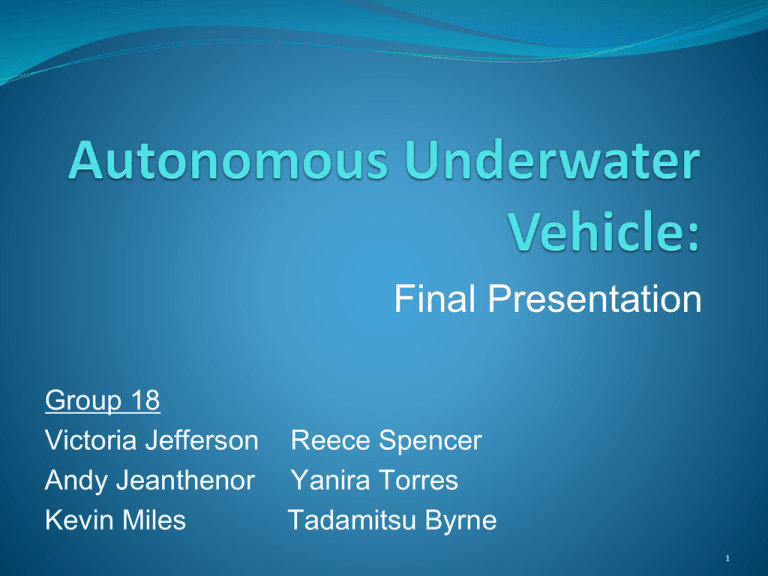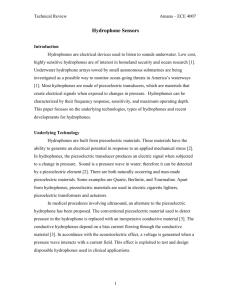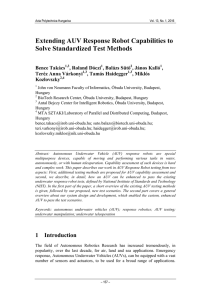AUV Proposal - FAMU-FSU College of Engineering
advertisement

Final Presentation Group 18 Victoria Jefferson Andy Jeanthenor Kevin Miles Reece Spencer Yanira Torres Tadamitsu Byrne 1 Project Overview Autonomous Underwater Vehicle Competition Competing in TRANSDEC Anechoic Pool, CA in July 2011 Competition Overview AUV will complete tasks underwater 15 minute time limit per run 6 underwater tasks Graded on completion of tasks as well as team design 2 Preliminary Rules Theme: RoboLove Tasks Validation gate Orange Path Buoys Love Lane Marker Dropper or Torpedo Acoustic Pinger and rescue Surface in octagon Weight and size constraints Must weigh under 110 pounds (Our AUV: appox. 50 lbs.) 6ft long, 3ft wide, 3ft high (Our AUV: 2.5 x 2.0 x 0.75 ft) 3 4 Frame Overview 80/20 Extruded Aluminum Can easily adjust and move every component Corrosion resistant Design from previous year was pretty, but very difficult to adjust and manufacture Shape is negligible at low speeds 5 Hull Overview Hull consists of a watertight Pelican Box (1450 Model) Purchasing Pelican Box is more simple than designing watertight housing and is also inexpensive Hull will house all onboard electronics Box size was chosen based on size of batteries and onboard electronic components 6 Marker Dropper Marker must be dropped in a box on the pool floor Utilize Traxxas 2056 waterproof servomotor that will rotate arm to release markers This method was chosen because due to simplicity and low cost – used scrap aluminum from machine shop First design used electromagnets and was more complex The device successfully dropped both balls on command 7 8 Camera Housing Design Original design involved large diameter PVC pipe and metal latches PVC was too thin and metal latches were too large Final design uses acrylic and aluminum shell with acrylic viewing lens Homemade clamps compress O-rings and keep housing water-tight 9 Waterproofing Methods The first method proposed was to use SubConn or Fischer premade connectors – very expensive, but easy Alternative method 1: Connect pelican box and camera housing using vinyl tubing Method 2: A combination of vinyl tubing and epoxy Final solution: Camera Housing: Method 1 Hydrophones/servo: Method 2 Thrusters: SubConn connectors 10 In-water Testing The buoyant force of the Pelican Box was +35 lbs The camera housing was approximately neutral without camera No leaks penetrated either container after 15 minutes at a depth of 10 ft Lead weights and sealed PVC pipes will be attached to the frame to make the AUV neutrally buoyant 11 12 Major Power Components Batteries Two 14.8 V DC batteries combine for 29.6V DC output Built-in PCM maintains a voltage between 20.8 V and 33.6 V Motors Max Power: 150W(each motor) Built in Motor Controller Switching Voltage Regulator (S.V.R.) for USB Power 15V-40V input Output 5.17V, 6A 13 14 Thruster Overview SeaBotix SBT150 thrusters were chosen for functional ability and water resistance as well it’s built-in motor controller, voltage regulator, and low power consumption Four thrusters will be placed on the AUV in a configuration that will allow for forward/reverse motion, left/right turning and depth control Other thrusters were more expensive, larger, and had higher power consumption 15 Electrical Tests Product Test Procedure Expected Results Achieved Results Pass/Fail SVR Output Voltage Output: 5.3V 5.176V Pass Battery (2) Output Voltage Output: 29.6V 33V Pass Switch On/Off Handles 150W Handles 150W Pass Thruster Plate Waterproof No continuity underwater No continuity underwater Pass SubConn Connectors Waterproof N/A, Waiting Arrival N/A N/A 16 17 Prioritization of Sensors Cameras Function: Eyes underwater Need: Critical (used in all tasks) IMU Function: Sense of Direction Underwater Need: Moderate Hydrophones Function: Ears Underwater Need: Low (used in only one task) 18 Software for Sensors Cameras Originally OpenCV Last minute change: Matlab Image Processing Due to Linking errors IMU RS-232 interface Linux C Source Code 19 Cameras Original choice was Unibrain Fire-I, but the software was not compatible with our system Three Logitech Quickcam Pro 4000 webcams will be used Needed for light/color and shape recognition CCD camera chosen for ability to operate in low light conditions The cameras chosen for cost efficiency as well as compatibility with our software 20 Camera Tests Type of Test Description of Test Pass/Fail Unit Ensure proper configuration in OpenCV software Fail Unit Test for acceptable quality images Pass Integration Compatible with microprocessor Incomplete Integration In Camera housing/produces same quality images Incomplete 21 Inertial Measurement Unit Navigation/Stability Control PhidgetSpatial 3/3/3-9 Axis IMU Accelerometer: measure static and dynamic acceleration (5g) Compass: measures magnetic field (±4 Gauss) Gyroscope: Measures angular rotation (400°/sec) Chosen for low cost and because it contained a compass instead of magnetometer unlike other IMUs 22 IMU Tests Type of Test Description of Test Pass/Fail Unit Ensure operational capabilities on Windows Pass Unit Functionality on Linux Pass Integration Compatible with microprocessor Incomplete 23 Control System: BeagleBoard The BeagleBoard(CPU): Single Board Computer Operating System: Angstrom-BeagleBoard demo Programming: CodeSourcery GNU Toolchain (Cross Compiler) Outputs: I2C USB/Serial Program will run real-time 24 Control System: Arduino Arduino Duemilanove Microcontroller Board Programming: Arduino IDE C Programming Language Built-in Libraries Outputs: PWM ADC UART TTL (5V) serial communication/USB 25 Component Software: Motors Programming: Communicate with Motor Controllers via I2C BeagleBoard I2C operate at 1.8V, 5V needed to communicate with motor controllers TrainerBoard will be used as expansion board Motors tested with I2C ports on Arduino 26 Software Structure Start Path Found? Y Detect Current Task Path Lost? N N Follow Path To Objective N Y Search For Path Objective Found? Y Complete Objective N Finish Y Have All Task Been Completed Store Data and Increment Task Counter 27 Software Tests Component Type of Test Description of Test Pass/Fail Adruino Board Unit Checked for Incomplete factory hardware verification by reading the manual and make sure everything works as it should in the manual Beagleboard Unit The microcontroller and the sensors are fully powered by the proposed battery configuration. Incomplete 28 Software Tests Component Type of Test Description of Test Pass/Fail BeagleBoard Integration with I2C expansion BeagleBoard sends the appropriate instructions to the motors Incomplete Beagleboard Integration with Sensors Test whether the microcontroller and the sensors perform the functions needed for AUV operation properly Incomplete 29 30 Hydrophones SensorTec SQ26-01 hydrophone Full audio-band signal detection and underwater mobile recording Operates at desired sound level Performs in desired frequency range (22-40 kHz) 31 Hydrophone Configuration 4 hydrophones will be utilized to determine the location of the acoustic pinger 2 hydrophones will be placed horizontally to determine direction The other two will be vertical in order to determine the depth 32 Camera Housing Analysis Stress Tensor (Pa) •Acrylic cylinder •Acrylic viewing lens •Aluminum end cap 33 34 35 36 Item Quantity Price Main Battery 2 $920.25 Voltage Regulator 1 $80.00 Motors/Thrusters 4 $2884.29 Hydrophones 3 $609.99 Microcontroller 1 $31.44 BeagleBoard 1 Free CCD Camera 3 $413.96 Pelican Case 1 $87.40 Miscellaneous (ME & ECE) Wires/Electronic Kits/Cables & Connectors 8020 Frame N/A $789.38 N/A $220.68 Aluminum Plate 14 in x 12 in x ¼ in 1 $70.00 Inertial Measurement Unit 1 $162.23 Total Expenses N/A $6,269.62 37 Item Price Transportation (5 people driving, 2 flying) $3,000.00 Hotel Accommodations $1,500.00 (2 hotel rooms for 5-6 nights) Miscellaneous Expenses (such as replacement of damaged equipment) $1,500.00 Total Expenses $6,000.00 38 Special Thanks Northrop Grumman Harris Corporation ARM FAMU/FSU College of Engineering Dr. Harvey 39 References "Official Rules and Mission AUVSI & ONR's 13th Annual International Autonomous Underwater Vehicle Competition." AUVSI Foundation. Web. Sept.-Oct. 2010. <http://www.auvsifoundation.org/AUVSI/FOUNDATION/UploadedImages/ AUV_Mission_Final_2010.pdf>. Barngrover, Chris. "Design of the 2010 Stingray Autonomous Underwater Vehicle." AUVSI Foundation. Office of Naval Research, 13 July 2010. Web. 09 Nov. 2010. <http://www.auvsifoundation.org/AUVSI/FOUNDATION/UploadedImages/S anDiegoiBotics.2010JournalPaper.pdf 40










